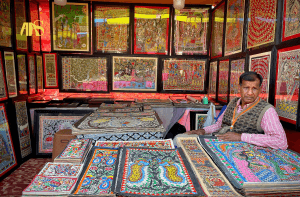Picture a canvas coming to life with rich, vibrant colors that seem to glow from within.
This is the magic of oil painting, an art form that has captivated artists and art lovers for centuries. But did you know that oil painting’s origins date back to the 7th century in Afghanistan?
It wasn’t until the 15th century that European artists like Jan van Eyck popularized this versatile medium, revolutionizing the art world.
Today, we’ll dive into the world of oil painting, exploring its unique characteristics, techniques, and enduring appeal that continues to inspire artists around the globe.
The Essence of Oil Painting
At its core, oil painting is a technique that uses pigments suspended in drying oils as a medium.
These oils, typically linseed, walnut, or poppy seed, allow for a slow drying time and create a painting with exceptional depth, richness, and longevity.
Key Components:
- Pigments: Finely ground color particles
- Binder: Drying oils that hold the pigments together
- Support: Usually canvas, but can also be wood panels or other surfaces
- Brushes: Various sizes and shapes for different effects
- Solvents and mediums: Used to thin paint or alter its properties
The Magic of Oil Paint
What sets oil painting apart from other mediums? Its versatility and unique properties make it a favorite among artists:
- Slow Drying Time: Unlike acrylic or watercolor, oil paints can stay workable for days or even weeks. This allows artists to blend colors seamlessly and make adjustments over time.
- Rich, Luminous Color: Oil paints offer unparalleled depth and intensity of color. The way light interacts with the layers of paint creates a luminous quality that’s hard to achieve with other mediums.
- Texture and Depth: From smooth, glassy surfaces to thick, textured impasto, oil paints can create a wide range of textures and dimensional effects.
- Durability: When properly cared for, oil paintings can last for centuries, retaining their vibrancy and detail.
Techniques in Oil Painting
Oil painting offers a wide range of techniques that artists can employ:
- Alla Prima: Italian for “at first attempt,” this technique involves completing a painting in one session, wet-on-wet.
- Glazing: Applying thin, transparent layers of paint over dry layers to create depth and luminosity.
- Impasto: Using thick layers of paint to create texture and dimension on the canvas.
- Scumbling: Applying a thin layer of opaque paint over a darker layer to create a hazy effect.
- Sfumato: A technique popularized by Leonardo da Vinci, involving subtle gradations of tone to create soft, hazy outlines.
Getting Started with Oil Painting
For beginners eager to try oil painting, here are some tips:
- Start with Quality Materials: Invest in good-quality paints, brushes, and canvas. Student-grade materials are fine for beginners, but professional-grade will offer better results.
- Understand Color Theory: Learn about color mixing and how different pigments interact.
- Practice Brush Control: Experiment with different brush sizes and shapes to create various effects.
- Learn About Mediums: Explore how different mediums can alter the properties of your paint.
- Be Patient: Remember, oil painting is a slow process. Embrace the drying time and use it to your advantage.
Famous Oil Paintings Through History
Oil painting has given us some of the most iconic artworks in history:
- “Mona Lisa” by Leonardo da Vinci (1503-1506)
- “The Starry Night” by Vincent van Gogh (1889)
- “The Persistence of Memory” by Salvador Dalí (1931)
- “The Scream” by Edvard Munch (1893)
These masterpieces showcase the versatility and enduring appeal of oil painting across different artistic movements and styles.
Additional Information: In recent years, there’s been a growing trend towards eco-friendly and non-toxic oil painting practices. Artists are increasingly turning to water-mixable oils and natural, solvent-free mediums to create safer studio environments.
This shift not only benefits the artists’ health but also aligns with broader environmental concerns.
Another emerging trend is the integration of digital technology in oil painting. Some artists are using digital sketching tools to plan their compositions before transferring them to canvas.
Others are experimenting with augmented reality to create interactive experiences with traditional oil paintings, bridging the gap between classical and contemporary art forms.
Conclusion
Oil painting is more than just a technique; it’s a journey of discovery and expression. Its rich history, versatile nature, and ability to capture light and emotion in unique ways continue to make it a beloved medium for artists and art enthusiasts alike.
Whether you’re an aspiring artist or an art lover, understanding oil painting opens up a world of appreciation for this timeless art form.
So the next time you stand before an oil painting, take a moment to marvel at the layers of color, the play of light, and the artist’s hand that brought it all to life. Who knows? You might just be inspired to pick up a brush and start your own oil painting adventure.





